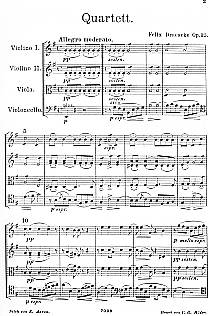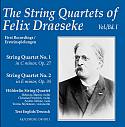FELIX DRAESEKE:
String Quartet No. 2 in E minor, Op. 36
Program notes prepared by Alan Krueck for the premiere recording of Draeseke's String Quartets for AK/Coburg Recordings. |
|
Section II of the biographical study of Felix Draeseke by Erich Roeder carries the title „At the Height of Instrumental Composition 1895-1888“ – and nothing could be more true or undeniable, for in this period a number of his best known and successful works came forth. Foremost among them one cites the Third Symphony, Op. 40, Symphonia tragica, but just before it came the monumental Piano Concerto in E flat major, Op. 36, and immediately after it the completion of the lyrically compelling String Quartet No. 2 in E minor, Op.35, which the composer himself designated as one of his favorite creations. In this period there also falls a great deal of work on the later successful opera Gudrun - with its magnificent overture – and which was finished in 1888. To begin this introduction to the String Quartet No. 2 in E minor, Op. 35 by Felix Draeseke, we take a look at two revealing paragraphs from the previously cited essay by Rainer Cadenbach in Volume 5 of the publications of the International Draeseke Society:
String Quartet No. 2 in E minor, Op. 36
The first movement of the String Quartet No. 2 begins with one the loveliest lyrical ideas in Draeseke’s output. Played surprisingly by the cello on first entrance, the theme is passed throughout the entire group and repeated before a brief transition brings the secondary theme (G major) built from a triplet motive. Erich Roeder maintains that this motive is later used in Draeseke’s last opera Merlin. From the second theme there evolves a third independent thematic unit and after a brief manipulation leads to a rather short development section. The triplet motive shows up once more and with it we reach the reprise. The second violin plays the lyrical idea of the opening and after rather agitated treatment of the second theme the first theme takes over the coda quasi-canonically and announces the exciting close. The second movement is the scherzo. A single theme formed from sixteenth notes prevails, but an opposing eighth note motive supplies rhythmic liveliness and fosters many an unexpected turn. The trio in C major is characterized by Erich Roeder as similar to a mazurka and reveals itself as a kind of dialogue between cello and accompanying violin. The plucked entrance of the materials announcing the repeat of the scherzo proper is truly charming. The third movement bears the inscription Adagio molto espressivo and is in 3/4 time throughout, with Erich Roeder maintaining that the tonality is C major – at the end to be sure, but the genial treatment of materials in the audacious counterpoint allows little time for normal harmonic analysis, and this lyrically gripping movement is above all contrapuntal. The opening measures unfold with inward hesitance. Right in the first measure the listener is confronted with an attractive but unstable auditive world in which all four instruments operate melodically independent throughout almost four octaves. It would not be far fetched to characterize the music as almost atonal, but E minor is established and from a chromatic line we recognize the first theme. Smaller motivic elements are brought into play. E major appears momentarily. A first climax is reached with the music hitting on differing tonalities in further development, until about 30 measures before the end when a final crescendo begins reaching to the highest range of the ensemble before a harmonic turn leads the music to C major and the movement ends transfigured, almost as at the beginning. Felix Draeseke has provided many a masterful example of his understanding of unendliche Melodie, but barely one so arresting in art and expression as here. The final movement (allegro molto vivace, E minor, 6/8) is for Erich Roeder the crown of the entire work. He describes it as „...a lively „through-composed“ rondo... a gigue-like irregular theme with its downward springing eighths winds upward...“ to launch the movement. An episode of intense longing is heard. In high register, a new episode in C major is developed and still another in F major follows. With the entrance of a final period in B minor, the music glides molto piu largo towards E minor and in a gesture of farewell, the magnificent main theme of the first movement reappears before a short presto coda invokes the breathtaking conclusion. |
|
Abschnitt II in der biographischen Studie über Draeseke von Erich Roeder trägt der Titel Auf der Höhe seiner Instrumentalmusik 1885-1888 - vollkommen zutreffend und unverleugbar, da in dieser Zeit eine Anzahl seiner bestbekannten und erfolgreichsten Instrumentalwerke entstehen. Vor allem zählen wir die dritte Sinfonie, die Symphonia tragica, Op. 40 dazu, aber ihr voran steht das monumentale Klavierkonzert in Es-dur, Op. 36 und diesem folgend das lyrisch ergreifende Streichquartett Nr. 2 in E-moll, Op. 35, welches der Komponist selbst ein Lieblingswerk nannte. In diesem Zeitraum fällt auch viel Arbeit an der später erfolgreichen Oper Gudrun – mit ihrer grossartigen Ouvertüre – die 1888 abgeschlossen wurde. Während das erste Streichquartett von Draeseke in einem Jahr grossen Liederschaffens komponiert wurde, weist das zweite Streichquartett seine Herkunft der damaligen konzentrierten Beschäftigung des Komponisten mit dem instrumentalen Klang auf. Muster ist – wie bei allen Streichquartetten Draesekes – unbestreitbar Beethoven Die Stimme ist natürlich Draesekes eigene. Es wäre interessant, ist aber unnötig festzustellen, Streichquartette Beethovens mit Draesekes Werken parallel zu gliedern. Immerhin rufen die Tonart des ersten Streichquartetts von Draeseke und dessen Auslegung das Beispiel von Beethovens Op. 18, Nr. 4 hervor und Draesekes selbstbekannte Liebe zu Beethovens Op. 131 und dessen Tonart in Draesekes Streichquartett Nr. 3 in Cis-moll, Op. 66 sind auch nicht ausser Betrachtung zu lassen. Nehmen wir also an, daß Draeseke auch Anregungen zum komponieren des zweiten seiner Streichquartette durch die mittleren Streichquartette Beethovens – sagen wir Rasumowsky in E-moll, Op. 59, Nr. 2 – bekommen hätte. Betrachten wir doch zu Beginn der Einführung in das Streichquartett Nr. 2 in E-moll, Op. 35 von Felix Draeseke zwei erhellende Paragraphen aus dem oben erwähnten Aufsatz von 1990 von Rainer Cadenbach im Band 5 der Veröffentlichungen der Internationalen Draeseke Gesellschaft:
Streichquartett Nr. 2 in E-moll, Op. 35
Der erste Satz des Streichquartetts Nr. 2 beginnt mit einer der schönsten lyrischen Erfindungen im ganzen Werk von Draeseke. Zuerst sehnsuchtsvoll vom Cello vorgetragen, wird das Thema durch das ganze Ensemble fortgeführt und wiederholt, ehe eine kurze Überleitung das zweite Thema (G-dur) präsentiert, deren Entwicklung ein aus Triolen gebildetes Motiv hervorruft. Roeder behauptet, daß dieses Motiv auch später in Draesekes letzter Oper Merlin verwendet wird. Ein drittes vom zweiten Thema entsprossenes, aber unabhängiges Thema folgt, und das nach deren Behandlung zu der eher kurzen Durchführung führt. Das Triolenmotiv taucht wieder auf und damit sind wir bald am Ende im Wiederholungsteil. Die zweite Geige spielt den ersten lyrischen Gedanken des Anfangs und nach agitierender Behandlung des zweiten Themas übernimmt das erste Thema quasi-kanonisch die Koda, welche einen feurigen Schluß ankündigt. Der zweite Satz ist das Scherzo (allegro vivace E-moll, 3/4). Ein einziges aus Sechzehnteln geformtes Thema vorherrscht, aber dem ein entgengetztes Achtelmotiv fördert rhythmische Lebendigkeit und breitet manche überraschenden Momente. Das Trio (C-dur) wird von Erich Roeder als mazurkaartig bezeichnet und weist sich musikalisch als ein Zwiegespräch zwischen Cello and begleitender Geige auf. Ganz charmant ist der gezupfte Eintritt des Materials in der Wiederholung des Scherzoteils.
Für Roeder ist der Schlußsatz, Allegro molto vivace (E-moll, 6/8) die Krönung des Quartetts. Er beschreibt ihn als “… eine heiteres “durchgeführtes” Rondo. Ein gigueartiges, unregelmäßiges Thema, dessen abwärtsspringende Achtel sich sofort emporwinden” eröffnet den Satz. Eine sehnsuchtsvoll lyrische Episode kommt zu Gehör. In hoher Lage taucht eine neue Episode in C-dur auf und in F-dur folgt eine weitere Rondoepisode. Mit Eintritt der Schlußepisode in H-moll gleitet die Musik molto piu largo nach E-moll und mit einer Abschiedsgeste erscheint der herrliche Hauptgedanke aus dem ersten Satz, ehe eine kurze Presto-Koda den brillanten Ausgang bringt. © Alan H. Krueck |
|
| Draeseke's Second String Quartet on CD: | |
"These string quartets are richly scored, and are excellent examples of Late German Romantic chamber music, with beautiful flowing melodies, highly satisfying emotional content, and engaging part-writing. The second quartet will most likely become the most popular, although all three are very enthusiastically recommended!" from a review at classical.net |
|
[Chamber Music] [Orchestral Music] [Keyboard Music] [Listen: mp3 - Real Audio] [Top]
© All contents copyright by the International Draeseke Society

